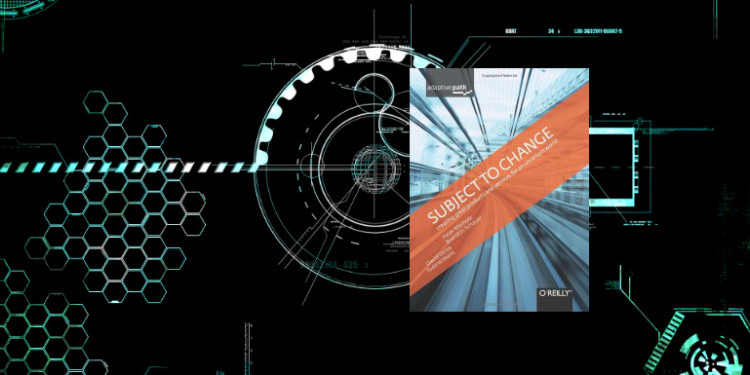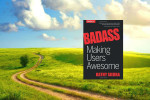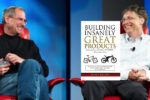The Experience is the Product

Creating great products in an uncertain world requires changing the way you think about your customers, products, and development process.
Subject To Change: Creating Great Products & Services for an Uncertain World: Adaptive Path on Design by Peter Merholz, Brandon Schauer, David Verba and Todd Wilkens
Subject to Change describes the evolution of three aspects of product development: customers, products, development. Approaching your customers as people rather than passive consumers provides a new view of opportunities. Considering the entire system and context in which a customer interacts with a product, rather that viewing a product a s standalone entity, enables greater value to be created. Using Agile methodologies, rather than a traditional Waterfall approach, enables a more sane, responsive, and adaptive way to bring products and services to your customers. Rather than trying to predict the future, these strategies create a closer relationship to the customer and market. This book provides the rationale, strategies, and tactical considerations for user experience centered product design.
To be uncertain is to be uncomfortable, but to be certain is to be ridiculous.
Adaptive Path co-authors Peter Merholz, Brandon Schauer, David Verba, and Todd Wilkens identify three organizational competencies essential to great product and service development: customer research, design, Agile technology implementation. These competencies help address the uncertain context that surrounds product and service development. Not only is there uncertainty in the marketplace, but the product design and development process itself is murky because “people are inconsistent, often inarticulate, and they challenge social and cultural boundaries in unexpected ways.” Comfort with uncertainty comes from a flexible approach grounded in a product vision and closeness to your customers. Instead of attempting to predict the future, it is better to be responsive and adaptable.
All that matters to customers is their experience.
The cornerstone of Subject To Change is the experience the end user has when interacting with your product or service. Focusing on the customer experience allows a closer relationship to customers and the ability to add more significant value than can be done through a more limited view. Because “humans invest nearly all of their experiences with meaning”, the product entire design team must have a shared understanding of the meanings that customer has assigned to the product or service experience. The authors observe that, “to stay viable, product categories require a quantum evolution that takes them beyond technology and features and on to the satisfaction of a customer experience.”
Experience strategy
Experience strategies help your company to start designing from the outside in, i.e., from the perspective of those who will be using the product or service you’re providing. It’s an overarching plan that starts with the customer and works its way back through to your organization’s operations and infrastructure.
An experience strategy is much like Marty Cagan’s Product Principles, a statement or manifesto that guides the team. It’s a product’s North star and helps crystallize the end goal and decision making along the way.
Product development organizations have evolved from a technology focus (building what is possible or interesting) to a feature focus (building discrete features that encompass an end user benefit) to an experience focus (considering the entire context of use and resulting user experience). Getting closer to the customer and the meanings associated with a product provides a powerful context for design. This provides an outside-in perspective instead of the commonly used inside-out view that frequently fails to meet customers needs and desires. The product team must repeat to themselves: “we are not the target market” (unless they actually are).
Customer Research
The success of experience-focused products is contingent on everyone sharing an understanding of users and a vision of the experience because so many people play a role in delivering that experience.
Companies that make great products have changed their perspective on their customers over time. Initially, the people who used products and services were considered passive “consumers” or sheep-like beings who blindly follow advertising and marketing messages. This view evolved towards the commonly practiced “task / activity / preference” method in use in many product development methodologies where the end result is a feature. The user experience focus, however, uses motivations, behaviors, and meanings to understand, empathize with, and design for end customers. This view acknowledges that although people accomplish tasks and activities, what they really want is the experience or meaning associated with its performance and/or completion.
Although customer research can result in shelfware (“where good insights go to die”), it is successful when: 1) it is acknowledged as an organizational competency; and 2) it delivers outcomes that are actionable and durable (the findings have a life outside the initial research presentation or document). There’s no point in undertaking research if the end result does not have longevity. Design research “helps establish the constraints and opportunities that make great design possible.”
The Design Competency
Good design is humanistic (based in a empathetic understanding of the end user), generative (able to envision multiple alternatives), and based on making decisions (based on design constraints, business objectives, and strategy). Design is not “throwing out as many ideas as possible”. Much of the book covers examples of good and bad (not meeting anyone’s needs) design.
Begin with the experience you want to design for, and then–and only then–identify the components that will deliver it.
You have to recognize that a system will degrade, and make it such that such entropy doesn’t shatter the entire user experience.
The authors say that “the system is the product” and give several examples in the book of successful products that are built as part of a broader value system. The iPod/iTunes/iTune store combination illustrates how an entire ecosystem contributes to a positive experience and partitions outcomes (manage, purchase, listen) to various elements of the whole.
Many organizations are good at building technology, but “the ability to create a new technology isn’t synonymous with the ability to craft a desirable customer experience” because the focus and competencies are different. Elements of the final system can only be created after the ultimate experience has been envisioned.
Designing standalone “products” limits the value that can be created. Product teams should consider the entire system that must be in place to support and create the desired experience. Focusing too much on the product itself is problematic because “design can and will fail when it’s practiced outside of the context of systems and strategy.” The context of use provides design goals and constraints that are critical for success. In order to ensure that everyone in the company understands the desired experience, a clear strategy needs to be in place to help align efforts and assist in decision making.
Over-engineering is the flip-side risk to system-based design thinking. Trying to design each and every element of an environment can lead to a highly brittle creation that breaks when any of its parts does not function as designed.
Much like Stewart Brand in How Buildings Learn, the authors point out that design should be flexible enough to accommodate future uses and users. Good design carefully examines constraints and takes into account future opportunities.
Ideas are cheap, cheap, cheap; we can think of so many. All too often, though, our organizations treat them as tender, scarce, and special.
Ideas live in Power Point presentations, where they are treated like descriptions on the sealed box of a toy. Everyone reads the packaging but dreams up a different idea of the product or experience inside.
Because “ideas are neither scarce nor fragile,” they do not need to be protected and hidden from view. Bringing ideas out into the harsh light of day for team examination allows assumptions to be tested and refinements to occur before investments are made. Handling ideas requires a different skill set than daily operations.
Many companies are good at “managing” (optimization, process improvement, efficiency), but struggle with “doing” (innovation, execution) because consistency, precision, and repetition do not translate into the variation, failure, and serendipity required for great products. Product development usually begins in a hazy environment where “anticipation far exceeds insight, plans seem arbitrary, no amount of research is enough, and uncertainty runs rampant.” Applying optimization won’t help at that stage.
Agile Development
In an environment where exploration leading to a dead end is viewed as an expense to be reduced, true innovation is difficult.
The Agile approach is the answer to the question “what are you doing to harness change to create greater value?” and combines highly iterative processes, bringing customers into the development process, creating smaller work groups, and in-line testing. Adopting the Agile perspective allows product development teams to decrease costs through small batch size, save time by creating less documentation, building essential feature sets based on continuous prioritization. (Here’s a great description of the Scrum product backlog, an essential component of Agile development).
The Long Wow
Are you building a platform that can create wow moments over the long haul?
The Long Wow is one of the outcomes of a customer experience strategy. It’s a way of thinking about your product or service in the context of customer touch points and opportunities for delight. The Long Wow is created by applying several strategies: 1) know your customer touch points and understand your platform for delivery; 2) draw from areas of continual unmet needs; 3) evolve repeatable processes for delivering wow moments; and 4) stage and plan the wow experiences. In the video below, Verba and Schauer advise to “pick points in time when your organization does things better than anyone else and focus on those.” Understanding your customers desires and context will allow the product team to “organize a pipeline of wow moments that can be introduced through your pallet of touch points over time.” The element of time is important because it is over multiple positive experiences that strong relationships are built.
Video: The experience is the product
In this video the co-authors, David Verba and Brandon Schauer, present “Subject to Change” to a GoogleTalk audience. Centered on the principle “the experience is the product”, the talk is divided into four segments: 1) focus on experience; 2) focus on the lives of customers; 3) embrace the complexity; and 4) engage in design as an activity.






